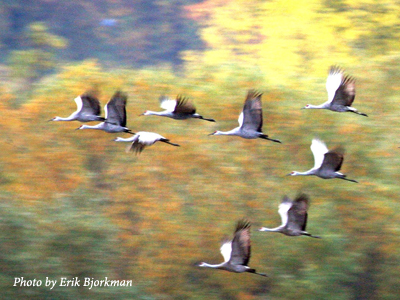We are grateful to International Crane Foundation Board Director, Paul King, for his tremendous investment of time and resources to save this important Sandhill Crane area in the northwestern United States. Sandhill Cranes are classified as an endangered species in the State of Washington, and it is through the dedication of individuals like Paul, and our partners the Columbia Land Trust, that we will ensure a future for this ancient species. ~ Rich Beilfuss, President & CEO, International Crane Foundation

A population of about 4,000 Sandhill Cranes nests in British Columbia’s Queen Charlotte Islands and adjacent areas of the Alaskan and British Columbia mainland. This region is linked to the crane’s wintering areas further south, where half of the population winters in the Columbia River lowlands near Portland, Oregon and Vancouver, Washington. The other half stage in this area for several months in the fall and then head further south for the winter to the northern part of California’s central valley.
On March 25, 2016 an important step was made for the protection of this important Sandhill Crane wintering and staging area in the Columbia River lowlands. A block of 541 acres of Columbia River lowlands was transferred to the Columbia Land Trust, a Washington-Oregon land conservation nonprofit organization, from the Port of Vancouver USA, a Washington state agency, for Sandhill Cranes and other species. The land is already used by the cranes for foraging and now will be improved with crops grown for their benefit. The transfer culminates years of negotiation between the Port and Columbia River Alliance for Nurturing the Environment (CRANE), a Washington nonprofit chaired by International Crane Foundation Board Director Paul King.
The transfer includes a $7 million grant from the Port to the Columbia Land Trust to develop crane-friendly infrastructure and endow the maintenance and farming of the land. A Habitat Plan for developing, farming, and maintaining the land for cranes and other wildlife, and for adaptive management as needed, was developed with the assistance of International Crane Foundation Research Associates Dr. Gary Ivey and Jeb Barzen. CRANE holds a conservation easement to ensure that the Habitat Plan is followed.
Over the past several decades, this Sandhill Crane population has grown steadily – although not rapidly – in number. The cranes have ample roosting habitat, but their foraging habitat, both in Washington-Oregon and in California, has been destroyed by conversion of cropland from row crops to fruit crops or to residential or commercial construction. The establishment of this block specifically to benefit cranes will reverse some of this habitat loss in the Columbia River basin and allow the population to continue to flourish.
This area is one of the few crane habitats in the United States within a major metropolitan area. The partners in the transfer are considering the possibility of nearby, but offsite viewing areas, where one day you may watch and learn about these iconic birds without disturbing them.
